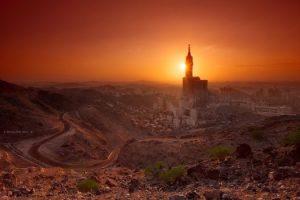By Tariq Ramadan
Life in the desert was to fashion the man and his outlook on creation and the elements of the universe and its whole nature. When Muhammad came to the desert, he was able to learn from the Bedouins’ rich oral tradition and their renown as speakers to develop his own mastery of the spoken language.

The desert is often the locus of prophecies as it naturally offers to the human gaze the horizons of the infinite.
Later on, the Last Prophet (peace be upon him) was to stand out through the strength of his words, his eloquence, and above all his ability to convey deep and universal teachings through short, pithy phrases (Jawami` al-kalim).
The desert is often the locus of prophecies because it naturally offers to the human gaze the horizons of the infinite. For nomads, forever on the move, finitude in space is allied to a sense of freedom blended, here again, with the experience of fleetingness, vulnerability, and humility. Nomads learn to move on, to become strangers, and to apprehend, at the heart of the linear infinity of space, the cyclical finitude of time.
Such is the experience of the believer’s life, which the Prophet was later to describe to young `Abdullah ibn `Umar in terms reminiscent of this dimension: “Be in this world as if you were a stranger or a wayfarer.” (Al-Bukhari)
Nature & the Divine
In the first years of the Prophet’s life he developed a specific relationship with nature that remained constant throughout his mission. The universe is pregnant with signs that recall the presence of the Creator, and the desert, more than anything else, opens the human mind to observation, meditation, and initiation into meaning.
Thus, many verses of the Qur’an mention the book of creation and its teachings. The desert, apparently devoid of life, repeatedly shows and proves to the watchful consciousness the reality of the miracle of the return to life:
And among His Signs is this: you see the earth humble (because of drought); but when We send down rain to it, it is stirred to life and yields increase. Truly, He Who gives it life can surly give life to the dead, for He has power over all things. (Fussilat 41:39)
This relationship with nature was so present in the Prophet’s life from his earliest childhood that one can easily come to the conclusion that living close to nature, observing, understanding, and respecting it, is an imperative of deep faith.
Many years later, when the Prophet was in (Madinah) Medina, facing conflicts and wars, a Revelation in the heart of night turned his gaze toward another horizon of meaning:
In the creation of the heavens and the earth, and the alternation of night and day, there are indeed signs for all those endowed with insight. (Aal `Imran 3:190)
It has been reported that the Prophet wept all night long when this verse was revealed to him. At dawn, when Bilal, the muezzin, coming to call for prayer, asked about the cause of those tears, Muhammad (peace be upon him) explained to him the meaning of his sadness and added: “Woe to anyone who bears that verse and does not meditate upon it!”

Living close to nature, observing, understanding, and respecting it, is an imperative of deep faith.
Another verse conveys the same teaching , referring to multiple signs:
In the creation of the heavens and the earth; in the alternation of night and day; in the sailing of the ships through the ocean for the profit of humankind; in the rain that God sends down from the skies, and the life which He then gives to the earth after it had been lifeless; in the beasts of all kind that He scatters through the earth; in the change of the winds, and the clouds that run their appointed courses between the sky and the earth; (here) indeed are signs for a people who are wise. (Al-Baqarah 2:164)
The first years of Muhammad’s life undoubtedly fashioned his outlook, preparing him to understand the signs in the universe.
The spiritual teaching that can be drawn from them is essential, both for the Prophet’s education and for our own education throughout history: being close to nature, respecting what it is, and observing and meditating on what it shows us, offers us, or takes (back) from us requirements of a faith that, in its quest, attempts to feed, deepen, and renew itself.
The Companion of Faith
Nature is the primary guide and the intimate companion of faith. Thus, God decided to expose His Prophet, from his earliest childhood, to the natural lessons of creation, conceived as a school where the mind gradually apprehends signs and meaning.
Far removed from the formalism of soulless religious rituals, this sort of education, in and through its closeness to nature, fosters a relationship to the divine based on contemplation and depth that will later make it possible, in a second phase of spiritual education, to understand the meaning, form, and objectives of religious ritual.
Cut off from nature in our towns and cities, we nowadays seem to have forgotten the meaning of this message to such an extent that we dangerously invert the order of requirements and believe that learning about the techniques and forms of religion (prayers, pilgrimages, etc.) is sufficient to grasp and understand their meaning and objectives.
This delusion has serious consequences since it leads to draining religious teaching of its spiritual substance, which actually ought to be its heart.
_________________________
The article is an excerpt from Dr. Tariq Ramadan’s book “In the Footsteps of the Prophet: Lessons from the Life of Muhammad, Oxford University Press (2007).
 Arabic
Arabic English
English Spanish
Spanish Russian
Russian Romanian
Romanian Hindi
Hindi Tagalog
Tagalog Bengali
Bengali Sinhalese
Sinhalese Nepali
Nepali

